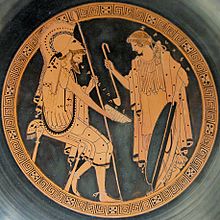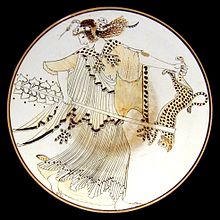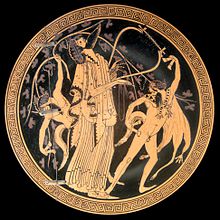Brygos Painter


The Brygos Painter was an ancient Greek Attic red-figure vase painter of the Late Archaic period. Together with Onesimos (vase painter), Douris and Makron, he is among the most important bowl painters of his time. He was active in the first third of the fifth century BCE, especially in the 480s and 470s. He was a prolific artist to whom over two hundred vases have been attributed, but he is perhaps best known for the Brygos Cup, a red-figure kylix in the Louvre which depicts the "iliupersis" or sack of Troy.
The Brygos Painter's conventional name is derived from the potter Brygos who is known from signatures. The Brygos Painter appears to have painted the majority of bowls produced by Brygos. The name Brygos appears on several vases and cups of the late 6th century BCE and early 5th century BCE. It is not known whether the signature refers to the potter or painter or indeed whether the two roles were separate, by convention they are referred to as two distinct individuals.
He was one of the most productive painters of his generation; more than 200 vases have been attributed to him. Apart from bowls, he also paonted other vase shapes, such as skyphoi, kantharoi, rhyta, a kalathos-like vessel with a pouring spout and a number of lekythoi. By far the majority of his works were bowls of the types B and C. The latter were often executed without maeander base lines, the former frequently stood on conical bases. The maeanders around his tondo paintings are rarely continuous, most are interrupted by sets or rows of crosses. Apart from his red-figure work, the Brygos Painter is known to have produced some white-ground vases.


Stylistically, the Brygos Painter is in a tradition with the early works by Onesimos. The influence of Onesimos is apparent in the Brygos Painter's use of twisting limbs and dramatic foreshortening, it is a possibility that Brygos was a pupil of Onesimos. Especially at the beginning of his career, he is bold and inventive. His drawing is not almost of the utmost precisions, but the postures of his figures and the expressiveness of their faces are outstanding. He is considered as the Archaic painter who had achieved the highest mastery of depicting body postures. He also is one of the first, and very few, painters who managed to paint a child to truly look like a child, and not like a small adult. Much of this suggests that he based his work on acute observation. Many of his figures also clearly display the effects of age. Typical motifs are symposium and palaistra scenes. Flat skulls, long noses and narrow eyes with rather high eyebrows ate characteristics of his style. His skill in painting the human mouth is remarkable: he can depict them as whistling, singing, playing the flute or clenching their lips with a high degree of anatomic accuracy. Stubbly beards or stubbly hair (on old men), as well as first signs of balding are also typical.
His mythical scenes are frequently original. Thus, he depicts the body of Ajax being covered by Tekmessa, the handing-over of the body of Hector and other scenes from the Trojan War. Dionysiac scenes are common as well. A famous bowl depicts satyrs attacking the goddesses Iris and Hera. While Iris attempts to flee, hera is protected by Heracles and Hermes. Dionysos is present, but apparently uninvolved. As on many of the Brygos Painter's vases, the figures are named by inscription; at times he even describes what they say or call. In spite of his frequent use of writing, kalos inscriptions by the Brygos Painter are rare.
The Brygos Painter was associated with a broader circle of artists who were influenced by him or even worked with him at the workshop of the potter Brygos. These include the Foundry Painter, the Briseis Painter, the Dokimasia Painter, the Painter of Louvre G 265 and the Painter of the Paris Gigantomachy.
Bibliography
- John D. Beazley. Attic Red-Figure Vase-Painters. Oxford: Clarendon Press, 1963.
- John Boardman. Rotfigurige Vasen aus Athen. Die archaische Zeit. Philipp von Zabern, 4. Auflage, Mainz 1994 (Kulturgeschichte der Antiken Welt, Vol 4), esp p. 149-151, ISBN 3-8053-0234-7.
- The Getty Museum - Biography of the Brygos Painter Working in Athens in the early 400s B.C., the Brygos Painter was a prolific decorator of red-figure cups. Over two hundred vases have been attributed to him, including a limited number of shapes other than cups and some vessels in the white-ground technique. Having learned his craft from Onesimos, the Brygos Painter was himself quite influential and was the center of a large circle of painters. The Brygos Painter painted both genre and mythological scenes, being especially fond of depictions of symposia, athletes, and Achilles. His treatments of mythological scenes were often innovative, and he was also rather stylistically experimental. He had a greater interest in spatial effects and setting than did his contemporaries. By using dilute glaze washes to show three-dimensionality, his painting technique comes close to shading. As with most Greek vase-painters, the real name of the Brygos Painter is unknown, and he is identified only by the stylistic traits of his work. He is named after the potter Brygos, with whom he worked. Some scholars think the painter and potter may be one and the same person.



